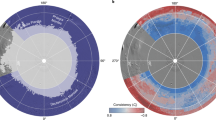Abstract
The inventory of water and carbon dioxide reservoirs on Mars are important clues for understanding the geological, climatic and potentially exobiological evolution of the planet1. From the early mapping observation of the permanent ice caps on the martian poles2,3, the northern cap was believed to be mainly composed of water ice, whereas the southern cap was thought to be constituted of carbon dioxide ice. However, recent missions (NASA missions Mars Global Surveyor and Odyssey) have revealed surface structures4, altimetry profiles5, underlying buried hydrogen6, and temperatures of the south polar regions that are thermodynamically consistent with a mixture of surface water ice and carbon dioxide7. Here we present the first direct identification and mapping of both carbon dioxide and water ice in the martian high southern latitudes, at a resolution of 2 km, during the local summer, when the extent of the polar ice is at its minimum. We observe that this south polar cap contains perennial water ice in extended areas: as a small admixture to carbon dioxide in the bright regions; associated with dust, without carbon dioxide, at the edges of this bright cap; and, unexpectedly, in large areas tens of kilometres away from the bright cap.
This is a preview of subscription content, access via your institution
Access options
Subscribe to this journal
Receive 51 print issues and online access
$199.00 per year
only $3.90 per issue
Buy this article
- Purchase on SpringerLink
- Instant access to full article PDF
Prices may be subject to local taxes which are calculated during checkout




Similar content being viewed by others
References
Kieffer, H. H. & Zent, A. A. Mars (eds Kieffer, H. H., Jakovsky, B. M., Snyder, C. W. & Matthews, M. S.) 1180–1220 (Univ. Arizona Press, Tucson/London, 1992)
Kieffer, H. H. Mars south polar spring and summer temperatures: a residual CO2 frost. J. Geophys. Res. 84, 8263–8288 (1979)
Paige, D. A., Herkenhoff, K. E. & Murray, B. C. Mariner 9 observations of the south polar cap of Mars: evidence of residual CO2 frost. J. Geophys. Res. 95, 1319–1335 (1990)
Smith, P. H. et al. The global topography of Mars and implications for surface evolution. Science 284, 1495–1503 (1999)
Schenk, P. M. & Moore, J. M. Stereo topography of the south polar region of Mars: Volatile inventory and Mars Polar Lander landing site. J. Geophys. Res. E 105, 24529–24546 (2000)
Boynton, W. V. et al. Distribution of hydrogen in the near surface of Mars: Evidence for subsurface ice deposits. Science 297, 81–85 (2002)
Titus, N., Kieffer, H. H. & Christensen, P. R. Exposed water ice discovered near the South Pole of Mars. Science 299, 1048–1051 (2003)
Mars Express Project Team. Mars Express: closing in on the Red Planet. ESA Bull. 115, 10–17 (2003)
Bibring, J.-P. et al. OMEGA: Observatoire pour la Minéralogie, l'Eau, les Glaces et l'Activité, (SP-1240, ESA, in the press)
Herkenhoff, K. E. Geologic Map of the MTM-85000 Quadrangle, Planum Australe Region of Mars (USGS Geologic Investigations Map Series I-2686, Washington, DC, 2001)
Thomas, P. C. et al. North–south geological differences between the residual polar caps on Mars. Nature 404, 161–164 (2000)
Byrne, S. & Ingersoll, A. P. A sublimation model for martian south polar ice features. Science 299, 1051–1053 (2003)
Nye, J. F., Durham, W. B., Schenk, P. M. & Moore, J. M. The instability of a south polar cap on Mars composed of carbon dioxide. Icarus 144, 449–455 (2000)
Clifford, S. M. et al. The state and future of Mars polar science and exploration. Icarus 144, 210–242 (2000)
Poulet, F., Cuzzi, J. N., Cruikshank, D. P., Roush, T. & Dalle Ore, C. M. Comparison between the Shkuratov and Hapke scattering theories for solid planetary surfaces: Application to the surface composition of two Centaurs. Icarus 160, 313–324 (2002)
Author information
Authors and Affiliations
Corresponding author
Ethics declarations
Competing interests
The authors declare that they have no competing financial interests.
Rights and permissions
About this article
Cite this article
Bibring, JP., Langevin, Y., Poulet, F. et al. Perennial water ice identified in the south polar cap of Mars. Nature 428, 627–630 (2004). https://doi.org/10.1038/nature02461
Received:
Accepted:
Published:
Issue Date:
DOI: https://doi.org/10.1038/nature02461
This article is cited by
-
Reply to: Explaining bright radar reflections below the south pole of Mars without liquid water
Nature Astronomy (2023)
-
Mars weather data analysis using machine learning techniques
Earth Science Informatics (2021)
-
Dust tides and rapid meridional motions in the Martian atmosphere during major dust storms
Nature Communications (2020)
-
Infrared spectroscopy finally sees the light
Nature (2020)
-
Experimenting with Mixtures of Water Ice and Dust as Analogues for Icy Planetary Material
Space Science Reviews (2019)




